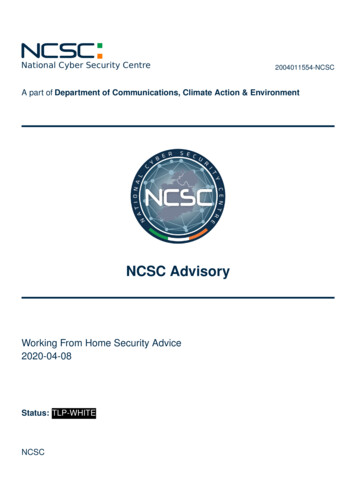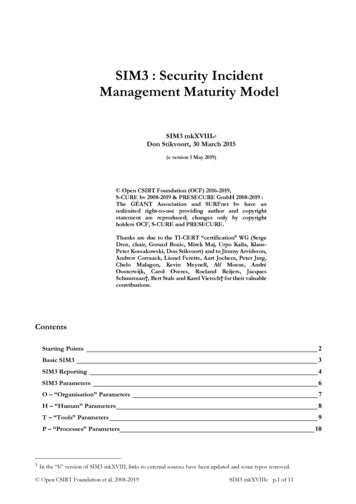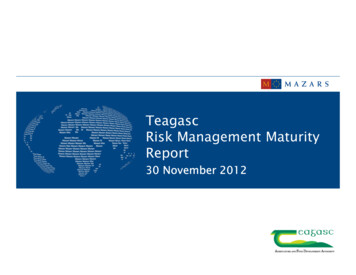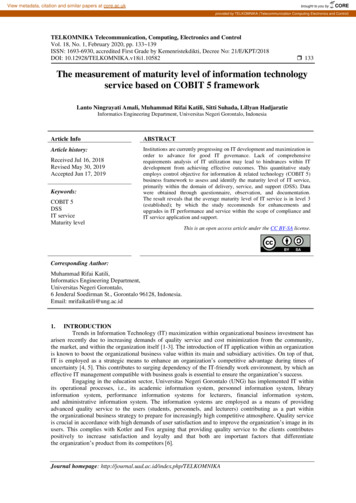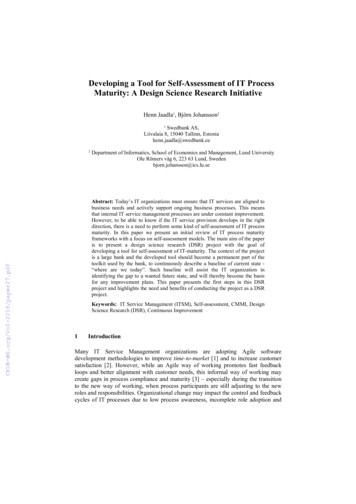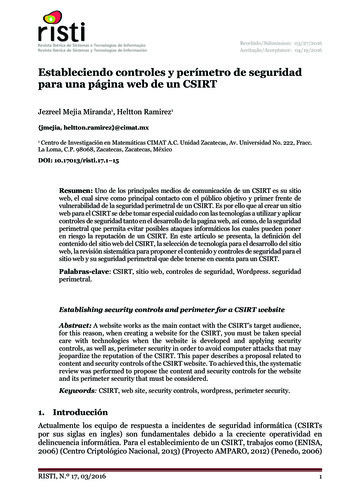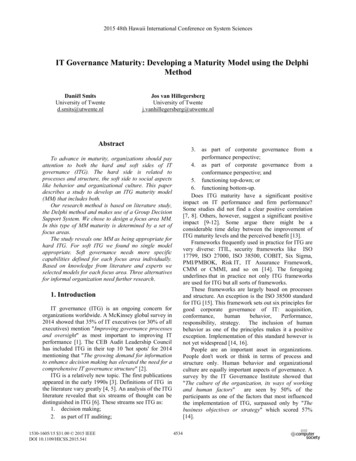
Transcription
CSIRT Maturity KitA step-by-step guide towards enhancing CSIRT Maturity8 April 2015National Cyber Security Centre, The Netherlandsinfo@ncsc.nl
TABLE OF CONTENTSEXECUTIVE SUMMARY . 2ACKNOWLEDGEMENTS. 2PURPOSE. 3TARGET AUDIENCE . 55.15.25.35.45.55.65.76FOUNDATION . 4CSIRT creation . 4CSIRT business plan . 4Measuring CSIRT Maturity . 5Addressing legal constraints. 5Case studies. 6ORGANISATION . 6CSIRT Services . 6Charter (Organisational Framework) . 6Incident Classification . 8National and international co-operation . 8HUMAN ASPECTS . 10Code of Conduct/Practice/Ethics . 10Personal Resilience . 10Skillset Description . 11Training (Schooling and education) . 11TOOLS . 13IT Resources List. 13Consolidated E-Mail System & Incident Tracking System . 13PROCESSES . 14Threat & Incident Detection Process . 15Incident Resolution Process. 15Emergency Accessibility Process . 15Information Handling Process . 16Constituency Outreach Process . 16Media Relations Process . 17AUP & Security Policy . 17CONCLUSION . 171
EXECUTIVE SUMMARYMaturity is an indication of how well an organisation governs, documents, performs andmeasures its activities. For instance, what are the steps taken to perform a certain service?Are these steps written down? What are the different roles of the team members? Are thesewell-defined? How is performance measured? Is it measured regularly?CSIRT maturity is, in turn, an indication of how well a team governs, documents, performsand measures the CSIRT services. Is the CSIRT aware of the various processes and therequired steps? Are these written down, shared, examined and improved? Is it clear what theCSIRT authority and accountability is? Are there mechanisms to ensure that the CSIRT followsthe formal processes and adequately serves its constituency? Are there mechanisms in placeto constantly learn and improve?The purpose of this CSIRT Maturity Kit is to help emerging and existing Computer SecurityResponse Teams (CSIRTs) to increase their maturity level. This is achieved by offering a set ofbest practices that cover CSIRT governance, organisation and operations. The document thatis presented now provides a starting point to guide CSIRTs through this process and serves asa basis for further international discussion on this topic and the exchange of best practices, inthe International One Conference 2015, the GCCS2015 and the Global Forum on CyberExpertise/CSIRT Maturity Initiative.This document identifies, and offers suggestions for improving, 5 areas of CSIRT maturity:1. Foundation – Creating and laying the foundation of your CSIRT.2. Organisation – Creating internal structures and joining the right networks.3. Human – Selecting and developing the most important asset of your team.4. Tools – Selecting and developing appropriate automation and infrastructure.5. Processes – Identifying and formalising the core services of your CSIRT.The cyber threat landscape is constantly changing and the responsibility to prevent, detectand respond to incidents is ever more challenging. To remain effective and meet thesechallenges, we must focus on capacity building, assisting others and exchanging knowledge.This not only benefits an individual CSIRT, but also benefits the entire community. Ifindividual countries have the capacity to effectively address threats in the digital domain, thencountries can collectively improve the quality of cooperation. Cyber security is a sharedresponsibility and requires a joint effort.Under the banner of capacity building, we must focus on increasing the maturity level of ourCSIRTs. These teams must evolve, and sometimes grow, to deal with the new challenges weface. Only when a team is strong, can it offer help to other teams. The CSIRT Maturity Kitguides CSIRTs through this process.ACKNOWLEDGEMENTSFor the realisation of this CSIRT Maturity Kit we would like to extend our gratitude to theCSIRT community for sharing their best practices, without which this document would nothave been possible. Furthermore we want to give our special thanks to the internationalreview committee for their valuable advice and support along the way.2
PURPOSEThe purpose of this CSIRT Maturity Kit is to help emerging and existing Computer SecurityIncident Response Teams (CSIRTs) to increase their maturity level quickly and effectively bybringing them in touch with a specific set of best practices that cover the main areas ofgovernance, organisation and operations of a CSIRT. These best practices are eitherreferenced or provided directly as part of the Kit and are placed in a logical context, withadditional explanations and advice wherever useful and possible.Thus, the CSIRT Maturity Kit, is a practical, hands-on document that can be directly applied byexperienced and inexperienced CSIRT professionals alike. The Kit is written in such a way asto help them navigate the vast range of possibilities for establishing or enhancing a CSIRT.Many choices have been made on content, by the authors, in consultation with aninternational review committee. Therefore, it is important to note that other ways of doingthings may be just as successful, and that other references or best practices can be used. Infact, collaboration with other maturity related efforts in the world will be an on-going effort.This Kit is not the last word in CSIRT matters, but rather an outreach to actually help teamsincrease their maturity efficiently. It is a living document that will be regularly updated withnew information when this becomes available, particularly after the ONE Conference and theGlobal Conference on Cyber Space GCCS2015.TARGET AUDIENCEThe primary target audience of this CSIRT Maturity Kit is national, critical infrastructure,corporate, research & education, and governmental CSIRTs worldwide. This kit will beespecially useful for recently created teams and teams who have not yet had the opportunityto consciously improve their maturity level.The subject matter of this kit is such, that we can safely recommend its use to all substantiallysized CSIRTs in all areas of society. We believe it will be beneficial to both novice andexperienced teams.3
1 FOUNDATIONThis chapter describes how to lay the foundation for your CSIRT1. This includes the varioussteps you should follow to create a new team, such as developing a business plan, assessingthe relevant legal frameworks and clearly identifying your constituency. Furthermore, thissection introduces the concept of CSIRT maturity and its vital role in the building a sturdyfoundation for your team.1.1 CSIRT creationThe European Union Agency for Network and Information Security (ENISA)2 provides awealth of documentation to assist CSIRTs. Included in this documentation is “A Step-by-StepApproach on How to Set Up a CSIRT” 3. This document offers a well-structured approach tosetting up a CSIRT and is available in 26 languages, including English, Spanish, Chinese, Hindiand Russian.An alternative, action-plan oriented approach to setting up a CSIRT is offered evelopment/action-list.cfm1.2 CSIRT business planWhat is the reason behind your decision to create a CSIRT? You need to establish this veryclearly. This needs to be more than only a formal decision – you must be able to easily explainit in speech and in writing. Formulate this into your “business plan”, which could also be partof e.g. a (national) cyber security strategy.The business plan should address how to gain support for your CSIRT. This means that you atleast:i. See how your CSIRT fits into your parent organisation’s cyber security strategy,whether that’s a commercial or not-for-profit organisation, a government, or a state.ii. Identify the stakeholders to cooperate with and/or to convince –and define a strategyand tactics for how to achieve this.iii. Identify the relevant cultural issues that come into play to make your CSIRT into asuccess – and plan how to turn those challenges into opportunities.Some interesting examples of relevant national strategies: New Zealand: ns/nz-cybersecurity-strategy-june-2011 0.pdfJapan: y.pdfThe Netherlands: etween-government-and-businesses.html1The term “CSIRT” meaning “Computer Security Incident Response Team” is a commonly used term. The term“CERT” is as common, however we avoid this in this Kit as this is a trademark of Carnegie Mellon University,home of CERT/CC.2 More information available at: http://www.enisa.europa.eu/3 Available online at: /guide4
1.3 Measuring CSIRT MaturityA useful tool for measuring CSIRT maturity is the Security Incident Management MaturityModel (SIM3). This model identifies 40 parameters that measure four categories of maturity:Organisation, Human, Tools and Processes. For each category, the SIM3 approach enables youto assess and subsequently increase the overall maturity of your CSIRT. You find the mostrecent version of SIM3 ence-Model.pdfSIM3 has been used to assess and certify teams of all kinds inside Europe: national,government, corporate, research and other teams. The certification uses a parameter profilewith minimum demands for each parameter. This is provided here for your rtification-Profile.pdfHowever, we recommend that you adapt the reference profile to your own needs, setting thepriorities that are important for your team. If you want your team to be certified by theEuropean CSIRT community, you can find more information on ication.html.An especially important pre-requisite of CSIRT maturity is support from your organisation’smanagement. For effectively building up your CSIRT maturity level it is essential that yourCSIRT has active management support. This means that your team has to be part of thegovernance and auditing in your organisation, as is referred to in the highest maturity level inthe SIM3 model. We strongly recommend that you make sure that at least the followingaspects of your CSIRT are at this level 4, meaning they are audited by at least onemanagement layer higher than your CSIRT leadership: CSIRT Charter (see 2.2 below) CSIRT service & service level description (can also be part of your Charter) CSIRT reporting & auditing process (can also be part of your Charter)You need these essential aspects to be supported and audited by the management of yourorganisation because the CSIRT primarily serves the interests of your organisation orconstituency as a whole. The CSIRT protects the primary/business process, the organisation’sreputation and all supporting processes. For example, in the case of a CIIP4 CSIRT thattranslates into protecting the critical information infrastructure of a country. Therefore thehighest form of governance in an organisation needs to take responsibility for the CSIRT andstimulate and support it. This must be reflected in governance, reporting and auditing.Specifically for national/governmental CSIRTs ENISA has a series of “baseline capabilities”documents at /baseline-capabilities .1.4 Addressing legal constraintsMost CSIRTs will be directly or indirectly involved in the protection of fundamental legalconstraints, like for instance: Data protection Healthcare non-public personal information protection Civil liberties Privacy4CIIP: Critical Information Infrastructure Protection5
You need to assess the legal framework that applies to these topics in your country and seehow it impacts your work. It is important to clearly understand how you must contribute, orcan be expected to contribute to the protection of such issues.
A useful tool for measuring CSIRT maturity is the Security Incident Management Maturity Model (SIM3). This model identifies 40 parameters that measure four categories of maturity: Organisation, Human, Tools and Processes. For each category, the SIM3 approach enables you to assess and subsequently increase the overall maturity of your CSIRT.

